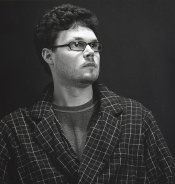Thomas Bertilsson
Member
How do you photograph someone so that the big reflection of your lighting doesn't occur on the eyeglass lenses?
This is a self portrait I made last night to test. Sorry if it isn't sharp all over, it wasn't easy with a 150mm lens and a self timer to get it right.
Can this be done?
Thankful for advice,
- Thomas
This is a self portrait I made last night to test. Sorry if it isn't sharp all over, it wasn't easy with a 150mm lens and a self timer to get it right.
Can this be done?
Thankful for advice,
- Thomas











 I just did this as a charity to a local school. There was a silent auction where people could bid on things donated to benefit the school. I donated a portrait session. Turned out the whole family wears eye glasses... We'll see how I did first. Then we'll know if I have to re-shoot or not.
I just did this as a charity to a local school. There was a silent auction where people could bid on things donated to benefit the school. I donated a portrait session. Turned out the whole family wears eye glasses... We'll see how I did first. Then we'll know if I have to re-shoot or not.
